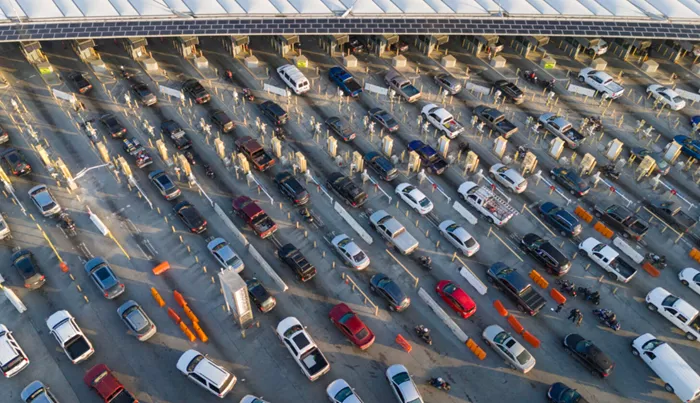A common claim made by opponents of immigration is that migrants contribute to rising crime rates in the U.S. Former President Donald Trump famously stated, “When Mexico sends its people, they’re not sending their best,” during his 2016 campaign. Similarly, Republican vice presidential nominee J.D. Vance remarked, “We know that when you have these massive ethnic enclaves forming in our country, it can sometimes lead to higher crime rates,” during a meeting with the Milwaukee Police Association.
However, numerous studies indicate the opposite. Immigrants are significantly less likely to commit crimes than U.S.-born citizens. A comprehensive study analyzing incarceration rates from 1870 to 2020 found that U.S.-born individuals consistently faced higher incarceration rates than immigrants. Currently, immigrants are 60% less likely to be incarcerated than their U.S.-born counterparts, according to the National Bureau of Economic Research.
Claims that immigrants cause crime spikes in their communities are also unfounded. FBI data shows that overall crime rates, including violent crime, have decreased in cities nationwide since their peak during the pandemic. While some politicians assert that border cities are plagued by lawlessness, the data reveals that crime rates, including homicides, are significantly lower than the national average.
Irayda Flores, a businesswoman in Phoenix, Arizona, finds the association of immigrants with crime exhausting. Flores moved to Arizona from Sonora, Mexico, in 2004 to pursue her entrepreneurial dreams. Her seafood wholesale business, El Mar de Cortez Corp, now serves numerous restaurants and employs over a dozen people. Despite this success, politicians continue to frame immigrants as criminals.
Flores says this rhetoric repeats every election cycle and overlooks the positive contributions many immigrants make in their new communities. “Politicians talk about the migrant community like they’re criminals,” she said. “But migrants leave their home countries in search of opportunity. They come here to work and improve their lives.”
Labeling all immigrants as criminals is damaging and unjust, she asserts. “You can’t generalize or treat an entire immigrant group as criminals,” she said. “Many have lived in this country for decades, benefiting the economy and their communities. They deserve respect.”
There’s an Invasion at the U.S.-Mexico Border
As campaign season heats up, politicians often describe the situation at the U.S.-Mexico border as an “invasion.” However, the reality is more nuanced. In late 2023, migrant encounters at the border reached record levels, with over 300,000 encounters in December alone. Experts attribute this surge partly to a global increase in migration patterns spurred by economic pressures during the pandemic.
In January 2024, encounters dropped sharply to around 176,000, eventually reaching a three-year low not seen since before the pandemic. The most recent data from August shows a slight increase to 107,503 encounters, up from 104,101 in July.
Fentanyl Is Smuggled into the Country by Migrants
The nearly 2,000-mile U.S.-Mexico border has 26 land ports of entry, where U.S. Customs and Border Protection agents monitor both official entry points and surrounding areas. Most fentanyl is smuggled into the U.S. through legal routes by U.S. citizens, according to the Department of Homeland Security. Over 90% of seized fentanyl is confiscated at these land ports. In fiscal year 2023, 86.4% of fentanyl trafficking convictions involved U.S. citizens.
Immigrants Take Advantage of Public Benefits
Most non-citizen immigrants are ineligible for public benefits in the U.S. Federal programs like Section 8 housing aid, Supplemental Nutrition Assistance Program (SNAP), Medicaid, and Temporary Assistance for Needy Families (TANF) are reserved for U.S. citizens.
Immigrants without citizenship cannot access Affordable Care Act subsidies or federal health insurance through the marketplace. However, legal permanent residents may qualify for some benefits after five years of residency.
Emergency Medicaid provides urgent medical treatment for migrants without legal status, and some benefits are available for migrant women under the Women, Infants, and Children (WIC) program. Eligibility for state public benefit programs varies, impacting access to driver’s licenses, in-state tuition, and scholarships.
In a recent naturalization ceremony in Plains, Georgia, a hundred people became citizens in celebration of former President Jimmy Carter’s 100th birthday. The process for migrants to gain citizenship is long and complex.
It’s Easy to Gain U.S. Citizenship
Becoming a U.S. citizen is a costly, complicated, multistep process. The backlog in naturalization and asylum applications results in long wait times for migrants. Those seeking legal status through marriage face various hurdles to prove their marriage is g
Related topics:
- Trump Believes the Border Helped Him Win in 2016 and Will Again
- Immigration Agency Seeks Assistance to Extradite Fraud Suspect
- Immigration Firm Owner Arrested for Cheating Man


